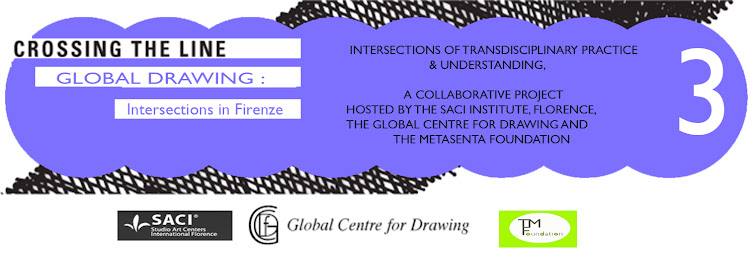photo by Florian Hirzinger-2013, source: Wikimedia Commons
Crossing the Line 3: Global Drawing Symposium
The third iteration of the Crossing the Line Conferences engages with ideas of ‘global’ drawing and mobility, highlighting shifts of meaning and consequences in different contexts.
Program November 6 2015,
SACI Institute
Via Sant'Antonino, 11, 50123 Firenze, Italy
Phone:+39 055 289948
Lecture Theatre
MORNING
8.45 Coffee and seating
9.00 Introductory Address by SACI Dean David Davidson.
9.10 /9.45 Introduction to the symposium and exhibitions paper: Dr Irene Barberis (Aust/UK)
Paper title: Global Drawing
9.50 Introduction of Keynote speaker, Dr Irene Barberis
9.55 Key note Address Dr Janet McKenzie (UK/Aust)
Paper title: To Travel Hopefully: The Road to Ardnamurchan.
10.55 Questions to keynote speaker
11.10 Morning tea
11.25 Dr Joe Graham (UK)
Paper title: ANCHOR: a drawing research project on the phenomenology of the 'outline'
11.55 Questions to Joe
12.00 /1.30 Lunch
1.30 Dr Elvira Souza Lima (Brazil)
Paper title: Drawing and Human Development
2.00 Questions to Elvira
20.10 Artists Lab Talk 1: Dr Marcelo Guimarães Lima (Brazil)
Presentation title: UMBRA: Shadow Drawings – read by Juliana Lima Dehne
2.45 Afternoon tea
3.00 Artists Lab Talk 2: Carole Robb (UK/USA)
Presentation title: The land of lost Intent
3.40 Associate Professor Julia Townsend (USA/AUD) to speak for ten minutes on the Middle Eastern team and students introducing the ‘Zincir’ workshop on the 7th November and introduces Stefan and Catja
3.50 Artists Lab Talk 3: Stefan Messam (USA/UAE)
Title: Resurrection Lands: Art Book meets Graphic Novel
4.10 Artists/Architect Lab Talk 4: Dr Catja de Haas (UK)
Presentation title: The Drawing of an Architect: Different Ways of Communication
4.30 Questions to Carole Robb, Stefan Messam and Catja de Haas and Julia Townsend
Symposium 6th November closes 4.45
5 .15/ 7pm Opening of the Contemporary Australian Drawing#5: Facsimiles, exhibition and the Metasenta Project’s inaugural Global Drawing Audit: Drawing Everywhere.
5.30 pm Introduction Curator: Dr Irene Barberis, exhibition opened by Dr Janet McKenzie
**For everyone interested in eating together after the opening, announcement on the day.
Nov 7.10.2015 SACI, the Drawing Room, 11 Via Saint Antonia
Artist Lab talks/ Masterclass /Specialised Workshop
all welcome
Drawing Masterclass given by Dr Irene Barberis: “ before we start…and then”
Specialised Workshop given by Associate Professor Julia Townsend
The logic of Zincir: the traditional border chain design of Islamic illumination
Artist Lab Talks: Hedy Ritterman & Liiliana Barbieri
1.00pm Gather in the SACI Drawing Room – Introduction to the afternoon by Irene Barberis
Artists Lab talks – 15 mins each led by Irene Barberis & Julia Townsend
1.10 Artist Lab Talk 5: Hedy Riterman (Aust)
1.30 Artist Lab Talk 6: Liliana Barbieri (Aust/Italy)
1.45 set up for Drawing Masterclass –
1.50 1 hour Drawing Master Class – “ before we start…and then”
Materials: drawing materials, drawing books, paper charcoal or pencils etc.
2.55 Break –
3.00 pm Introduction and CTL#3 specialised workshop from the Middle East
presented by Associate Professor Julia Townsend (USA/UAE)
“The logic of Zincir: the traditional border chain design of Islamic illumination”
This workshop will begin with points and lines on graph paper and a small ruler to create a ‘zincir,’ meaning ‘chain’ in Turkish. Following a few basic rules, participants will make single and double row versions, with variations, and figure out how to round corners with this commonly used ornament found in the illuminated pages of the Koran. In the last part of the class, students will see examples of zincir as used in ‘tezhip’--the general term for the Islamic manuscript decoration with gold paint and fine lines -- followed by the origins of this ‘knot’ tradition in Roman mosaics, including an example from the Crypt of Santa Reparata in Florence. A brief historical survey will show the broad range of ‘interlace’ through Scandinavian runestones, Celtic knots, Persian ceramics, Sapi carving, the floor of the Baptistry in Florence, and Chinese sculpture. Possible meanings will be discussed, and, time permitting, more variations pursued.
5,00 pm finish workshop and Crossing the Line #3 Global Drawing Symposium
SACI Florence (click the image to enlarge)
Via Sant'Antonino, 11, 50123 Firenze, Italy
Phone:+39 055 289948
Via Sant'Antonino, 11, 50123 Firenze, Italy
Phone:+39 055 289948




